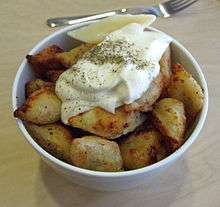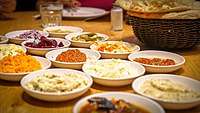Pelmeni
Pelmeni (Russian pronunciation: [pʲɪlʲˈmʲenʲɪ]; Russian: пельме́ни—plural, пельмень Russian pronunciation: [pʲɪlʲˈmʲenʲ]—singular) are dumplings of Russian cuisine that consist of a filling wrapped in thin, unleavened dough.
 Pelmeni served with smetana (sour cream) | |
| Type | Dumpling |
|---|---|
| Place of origin | Russia (Ural and Siberia) |
| Main ingredients | Dough: flour, water, sometimes eggs Filling: minced meat (pork, lamb, beef, fish, or any other kind of meat) or mushrooms as well as salt, pepper and sometimes herbs and onions. |
The debate about the exact place of origin is still active, with Ural and Siberia both maintaining strong claims.[1] Pelmeni have been described as "the heart of Russian cuisine."[2]
Ingredients
The dough is made from flour and water, sometimes adding a small portion of eggs.[3]
The filling can be minced meat (pork, lamb, beef, fish or any other kind of meat, venison being particularly traditional for colder regions) or mushrooms. The mixing together of different kinds of meat is also popular. The traditional Udmurt recipe requires a mixture of 45% beef, 35% mutton, and 20% pork.[4] Various spices, such as black pepper and diced onions as well as garlic, are mixed into the filling. They are commonly topped with sour cream, mayonnaise, dill, red onions or vinegar, all of which are traditional to the region and can be produced in the Siberian climate.
Adding small amounts of cabbage, tomato and horseradish as well right into the mince is common for certain regions.
Temperature and humidity have considerable impact on dough consistency and stability.
Origin and history
The first mention of a dish similar to dumplings comes from ancient Greece, but the Ural region seems to be the origin place of the pelmeni. The word pelmeni is derived from pel'n'an' (пельнянь)—literally "ear bread" in the native Finno-Ugric Komi and Udmurt languages.[5] It is unclear when pelmeni entered the cuisines of the indigenous Siberian people and when they first appeared in Russian cuisine. One theory suggests pelmeni, or stuffed boiled dumplings in general, originated in Siberia, possibly a simplified adaptation of the Chinese jiaozi (in some dialects it is called Bāomiàn "包面"). Another theory suggests that pelmeni were carried by the Mongols to Siberia and the Urals, from where they gradually spread as far as Eastern Europe. Pelmeni became especially popular by Russian hunters.[6][7]
Pelmeni are particularly good means of quickly preserving meat during long Siberian winter, especially eliminating the need to feed livestock during the long winter months. Thus, despite their Uralic origin, pelmeni were much influenced by the Siberian way of cooking.
Differences

Pelmeni belong to the family of dumplings, and are related to Ukrainian varenyky and Polish pierogi. In the United States and Canada, the term pierogi or perogies is often used to describe all kinds of Eastern European dumplings, regardless of the shape, size, or filling. Pelmeni are also similar to Mongolian bansh, Chinese jiaozi (Cantonese gaau) or Chinese húndùn (Cantonese wonton). They are cousins to the Turkish and Kazakh manti, the Nepalese and Tibetan momo, the Uyghur and Uzbek chuchvara, the Korean mandu, the Japanese gyoza, the Italian tortellini and ravioli, and Swabian Maultaschen. Somewhat similar are the fried or baked empanadas encountered in Hispanic-influenced cultures.
The most important difference between pelmeni, varenyky, and pierogi is the thickness of the dough shell—in pelmeni and vareniki this is as thin as possible, and the proportion of filling to dough is usually higher.[8] Pelmeni are never served with a sweet filling, which distinguishes them from vareniki and Polish pierogi, which sometimes are. Also, the fillings in pelmeni are usually raw, while the fillings of vareniki and pierogi are typically precooked.
The main difference between pelmeni and momos is their size—a typical pelmeni is about 2 to 3 centimetres (0.79 to 1.18 in) in diameter, whereas momos are often at least twice that size.
Regional differences

In Siberia, pelmeni are traditionally frozen outdoors in the winter and treated as preserved food. Hunters or explorers heading into the taiga would carry sacks of frozen pelmeni with their provisions as easily cooked, nonperishable food.[9] Pelmeni can be stored frozen for a long time and they are prepared immediately before eating by boiling in salted water until they float, and then two to five minutes more. Regional differences exist in the boiling of pelmeni. In the Urals, they are always boiled in water, while in Siberia they are boiled in salted water or sometimes meat or chicken broth.[9] The cooked pelmeni are served on their own or topped with melted butter or smetana (sour cream). Mustard, horseradish, tomato sauce, and vinegar are popular, as well. The people of the Russian Far East generally add soy sauce. Some recipes suggest frying pelmeni after boiling until they turn golden brown. Pelmeni can also be served in a clear soup,[10] although in Siberia this is considered in poor taste and pelmeni are carefully strained before serving.[9] In Tatar cuisine, Pilmän (the Tatar equivalent of pelmeni) are a traditional dish, where they have always been served with clear soup and added dill or other freshly cut herbs. Pelmeni are also a part of the Polish cuisine.
Packed frozen, pelmeni can be found in Russian and Ukrainian food stores, as well as everywhere Russian communities exist. Packets of frozen pelmeni are usually labeled "Siberian pelmeni" because of the Siberian practice of storing and transporting pelmeni in frozen form.[9] Store-bought pelmeni are made on industrial machinery, much of which is made by Italian companies such as Arienti and Cattaneo, Ima, Ostoni, Zamboni, etc. These pelmeni usually weigh around 15 grams (½ oz) each and look like a larger version of tortellini, which is why, for industrial production, Italian pasta machines are commonly used. Pelmeni are also commonly made at home. The easiest (if somewhat laborious) way is simply to make them by hand; many cooks use specialized "pelmeni makers" (Russian: пельменница, pelmennitsa), which are essentially molds that resemble muffin pans or ravioli molds, allowing one to quickly make a few dozen pelmeni out of two sheets of dough and a quantity of ground meat.
In modern Russian and Ukrainian culture, and also in the Baltic states and Poland, store-bought pelmeni are considered a kind of convenience food and are associated with students' or bachelors' lifestyles, much like instant ramen, etc.[10], while home-made pelmeni remain perceived as nutritious and healthy food.
See also
References
- "Pelmeni, Siberian Meat Dumplings | Food Perestroika". Food Perestroika. 2017-06-24. Retrieved 2018-10-03.
- "What is Pelmeni?". pelandmeni.com. Archived from the original on 2019-01-31. Retrieved 2019-01-30.
- Step-by-step instructions for preparation of pelmeni, with photographs (in Russian)
- Recipe for Ural pelmeni on pelemeni.ru (in Russian)
- Vasmer, Max (1986–1987) [1950–1958]. "пельмень". In Trubachyov, O. N.; Larin, B. O. (eds.). Этимологический словарь русского языка [Russisches etymologisches Wörterbuch] (in Russian) (2nd ed.). Moscow: Progress.
- http://russiapedia.rt.com/of-russian-origin/pelmeni/
- "What is Pelmeni?". pelandmeni.com. Retrieved 2019-01-30.
- 'Пельменів не буде — будуть равіолі?' (in Ukrainian)
- Siberian pelmeni on pelemeni.ru (in Russian)
- Pelmeni from SRAS – School of Russian and Asian Studies, California
